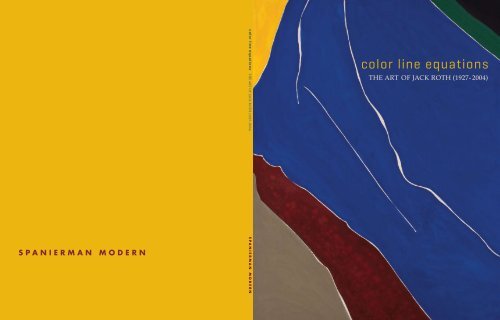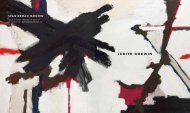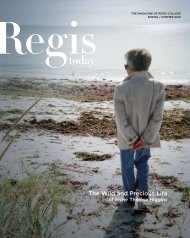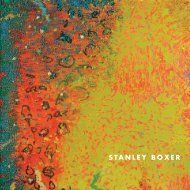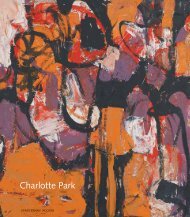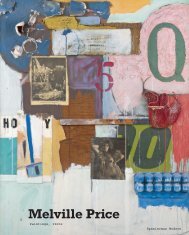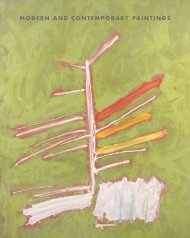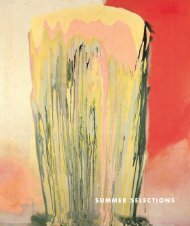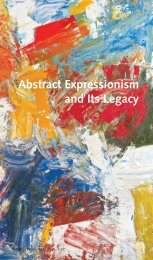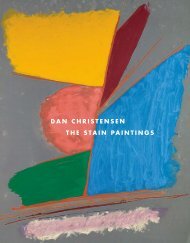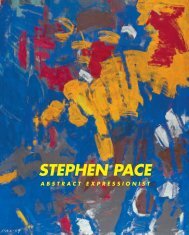The Art of Jack Roth: Color Line Equations - Spanierman Modern
The Art of Jack Roth: Color Line Equations - Spanierman Modern
The Art of Jack Roth: Color Line Equations - Spanierman Modern
- No tags were found...
You also want an ePaper? Increase the reach of your titles
YUMPU automatically turns print PDFs into web optimized ePapers that Google loves.
SPANIERMAN MODERNcolor line equations THE ART OF JACK ROTH (1927–2004) SPANIERMAN MODERNcolor line equationsTHE ART OF JACK ROTH (1927- 2004)
color line equationsTHE ART OF JACK ROTH (1927–2004)ESSAY BY THOMAS MCCORMICKMAY 12 – JUNE 11, 2011SPANIERMAN MODERN53 EAST 58TH STREET NEW YORK, NY 10022-1617 TEL (212) 832-1400MCAMPBELL@SPANIERMAN.COMWWW.SPANIERMANMODERN.COM
discovery…For those <strong>of</strong> us who devote our lives to the art business,one <strong>of</strong> our passions is discovering a forgotten artist.When that happens, we all share in the exhilaration.<strong>Jack</strong> <strong>Roth</strong> created a brilliant body <strong>of</strong> work over a longcareer, beginning in the late 1940s, when he workedin San Francisco with Mark <strong>Roth</strong>ko and Clyfford Still.Along the way, he became a Guggenheim Fellow—noeasy accomplishment—and joined the legendarystable <strong>of</strong> artists represented by M. Knoedler & Co. inNew York. <strong>Roth</strong> painted his way through the majordevelopments in postwar American art, from AbstractExpressionism, through Pop, and ultimately through<strong>Color</strong> Field abstraction. His broadly stained canvases <strong>of</strong>the 1970s and ’80s are crisp, fresh, and smart. A brilliantmathematician (and a poet!), <strong>Roth</strong> brought considerablepowers to the game, placing his unique signature on thedevelopment <strong>of</strong> abstract painting in America.1. metafour #1, 1980Acrylic on canvas30 x 68 inchesSuffering from poor health for several years prior to hisdeath in 2004, <strong>Roth</strong> stored away much <strong>of</strong> his work in anonion barn in Chester, New York—creating a treasurechest waiting to be opened. With this exhibition we hopeto revive interest in a painter <strong>of</strong> tremendous talent andfervor, whose work is as compelling and vital today aswhen he put brush to canvas over sixty years ago.Ira <strong>Spanierman</strong>2 3
color line equationsTHE ART OF JACK ROTH (1927–2004)<strong>The</strong>se paintings arealmost dangerouslyeasy to like, but theyhave teeth, and thoseteeth are kept ingood order.John Russell, New York Times (1980)<strong>Jack</strong> <strong>Roth</strong>, ca. 1980<strong>The</strong>re has long been a divide between the disciplines <strong>of</strong> art and science, and it is rare for a personto possess the skill to not only cross the line but to excel in both worlds. Such a label may fairly beapplied to the Abstract Expressionist painter <strong>Jack</strong> <strong>Roth</strong>. His talent, success, and passion as a painterwere equaled by his pursuit and mastery <strong>of</strong> mathematics, poetry, and photography. <strong>The</strong> painter’swife and partner <strong>of</strong> fifty years, the artist Rachel <strong>Roth</strong>, recently remembered him this way: “<strong>Jack</strong> wasthe hardest working person I’ve ever known. I’ve never said this before, but I think he was a genius,and I don’t say that lightly!”Rodney <strong>Jack</strong> <strong>Roth</strong> was born March 13, 1927 in Brockway, Pennsylvania. At his father’s deathin 1931 the family moved to Punxsutawney, Pennsylvania, where <strong>Jack</strong> had what he characterizedas a “normal” childhood. In 1943, he won a $35 Student Senatorial Scholarship and enrolled atPenn State University majoring in chemistry and agricultural-biochemistry. His narrow educationalviewpoint was liberated by a German pr<strong>of</strong>essor who encouraged students to pursue a morehumanitarian and well-rounded education. Delving into philosophy, literature, history, and art, <strong>Roth</strong>took a part-time job at the university library where he became an enthusiastic and copious reader.He particularly liked reading Baudelaire, Rimbaud, Zola, D.H. Lawrence, and Spengler.In June <strong>of</strong> 1945, <strong>Roth</strong> entered the Army where he had a variety <strong>of</strong> stateside assignments.<strong>The</strong>se included Japanese language school in Minnesota, Adjutant General’s School in Georgia,Air Force classification specialist in Washington, D.C., personnel inspector for the Strategic AirCommand, analyst at the Pentagon for the Adjutant General’s Office and finally insurance specialistat Letterman General Hospital in San Francisco. <strong>The</strong>re he married Colleen Bleier, an artist withwhom he had two children. Discharged from the service in 1948, he moved to Big Sur, where heaggressively worked in painting, drawing, and sculpture. His scientific thinking led him to develophis own formulation for linseed oil and earth pigments from the raw clays he dug locally. Heworked extensively in sculpture, in direct clay modeling, wood and metal constructions, and directwoodcarving. While in Big Sur he met a number <strong>of</strong> interesting characters, including the authorHenry Miller with whom he <strong>of</strong>ten played chess.<strong>Roth</strong> moved to San Francisco in 1949, where he hoped to study writing under the G.I. Bill, butenrolled instead at the California School <strong>of</strong> Fine <strong>Art</strong>s (later the San Francisco <strong>Art</strong> Institute). <strong>The</strong>rehe studied painting with Mark <strong>Roth</strong>ko, Clyfford Still, Richard Diebenkorn, David Park, and ElmerBisch<strong>of</strong>f. He was particularly influenced by Still, with whom he stayed friends later in life.His roommate at the time was Jon Schueler, with whom he also remained friendly later in NewYork. <strong>Roth</strong> was given his first solo exhibition in 1949 at the Little Gallery in Sausalito. While in theBay Area, he worked for a commercial silkscreen printer and the architect Forest Wright.In the fall <strong>of</strong> 1950, <strong>Roth</strong> returned to Penn State where he completed his bachelor’s degreein chemistry in 1951. Since his previous stint at Penn, <strong>Roth</strong> had come to realize that science wasless important to him than art, and he branched out into the study <strong>of</strong> art and music, giving lectures4 5
about the relationship <strong>of</strong> music and contemporary art. <strong>Roth</strong> next moved to the University <strong>of</strong> Iowafor graduate work, studying with James Lechay and Mauricio Lasansky. He also concentrated inmedieval, Asian, and modern art; Bergsonian philosophy; avant-garde American painting; Arabicand Chinese calligraphy; the influence <strong>of</strong> the I Ching on Southern Sung Painting; symbolismin the design <strong>of</strong> early Christian churches; and the relationship <strong>of</strong> non-figurative painting tomathematical physics. In June <strong>of</strong> 1953, he received his MFA with a thesis on Zen Buddhism andavant-garde painting in America.While in Iowa, <strong>Roth</strong> was busy with numerous outside activities as well; he foundeda cooperative gallery with four others called “Gallery 5.” He also reorganized a moribund oncampusstudent gallery called the Student <strong>Art</strong> Guild. He opened a commercial photographybusiness, photographed for the local paper, the Daily Iowan, and acted as art editor for a literarymagazine called Harbinger. A most important Iowa development was his introduction to a lovelyand talented art student named Rachel Chester, with whom there was instant chemistry. She wasone <strong>of</strong> the artists involved in founding Gallery 5. In May <strong>of</strong> 1953 <strong>Roth</strong> was divorced from his wifeand prepared to move to New York, arriving there in August. Separately, Rachel also headed toNew York.<strong>Roth</strong> settled on New York’s Lower East Side at 104 East 3rd Street, and he began looking forwork. His first job was in the <strong>of</strong>fice <strong>of</strong> a bra manufacturer, where he could outthink the calculatorsthey used for bookkeeping. He also freelanced as a reviewer and critic for <strong>The</strong> <strong>Art</strong>s Digest, wherehe reviewed a Frank Lloyd Wright exhibition at the Guggenheim Museum. In 1954, he and Rachelwere married. Seeking more secure employment he sent out hundreds <strong>of</strong> job applications, buthaving little success, he began considering a return to academia. Meanwhile, he continued towork odd jobs including as a hotel night clerk and an orderly at Beekman Downtown Hospital.Meanwhile, Rachel enrolled in night school at Columbia University, taking a degree in libraryscience; she believed this would help if he went for his Ph.D. <strong>Jack</strong> and Rachel also began work ona book project titled East Side Address. This was an ambitious work <strong>of</strong> one hundred photographsby <strong>Jack</strong>, each paired with a poem by George Noss, whom the couple had met in Iowa, where hehad been a member <strong>of</strong> the Iowa Writer’s Workshop.In 1954, <strong>Roth</strong> unsuccessfully applied for a John Simon Guggenheim Memorial FoundationFellowship in the field <strong>of</strong> photography, with the East Side Address project. However, he struckpr<strong>of</strong>essional gold when James Johnson Sweeney, director <strong>of</strong> the Solomon R. GuggenheimMuseum, tapped him for the seminal exhibition Younger American Painters. <strong>The</strong> fifty-seven artistsin the show included Baziotes, Diebenkorn, Gottlieb, Guston, Kline, de Kooning, Motherwell,and Pollock. Sweeney traveled the country to select the participants, resulting in the first museumexhibition to focus on many <strong>of</strong> the key Abstract Expressionists. Sweeney adapted a travelingversion <strong>of</strong> the exhibition, also including <strong>Roth</strong>, which toured to the Dallas Museum <strong>of</strong> Fine <strong>Art</strong>s,Indiana University, the Worcester Museum <strong>of</strong> <strong>Art</strong>, the Portland Museum <strong>of</strong> <strong>Art</strong> (Oregon), theHenry <strong>Art</strong> Gallery (Seattle), the San Francisco Museum <strong>of</strong> Fine <strong>Art</strong>s, the Los Angeles CountyMuseum, and the New Orleans <strong>Art</strong> Museum.In 1956, <strong>Roth</strong> started graduate work in mathematics at New York University. Two years later,beginning what he called his “Southern period,” he moved to Durham, North Carolina, wherehe enrolled in graduate mathematics at Duke University, and Rachel found work as the librarianfor the Trent Collection <strong>of</strong> the History <strong>of</strong> Medicine. <strong>Roth</strong> finished his Ph.D. in 1962, and whilewriting his doctoral thesis, he taught mathematics at the University <strong>of</strong> Kentucky in Lexington. Hetold a newspaper reporter once that life there was bearable only because he could listen to goodjazz, performed by patients from the famed, local drug rehab hospital. From 1963 to 1966, hetaught at the University <strong>of</strong> Southern Florida in Tampa. During this period he continued to makeart, although he traded in his brushes for pen and ink, working mostly in drawing. This was duemainly to a lack <strong>of</strong> suitable studio space and the demands <strong>of</strong> his graduate work.In 1963, <strong>Roth</strong> traveled to New York, where he presented work to the legendary Museum2. ibid #15, 1982Acrylic on canvas42 x 56 inches<strong>of</strong> <strong>Modern</strong> <strong>Art</strong> curators Dorothy Miller and William Lieberman. Miller immediately purchased alarge drawing for the museum by <strong>Roth</strong> titled Where Are <strong>The</strong>y Now. <strong>The</strong> work was shown that yearin the inaugural exhibition <strong>of</strong> the Paul J. Sachs Gallery, 60 <strong>Modern</strong> Drawings: Recent Acquisitions.Writing about the show in the New York Herald Tribune, John Gruen singled out <strong>Roth</strong>:One <strong>of</strong> the best drawings is by <strong>Jack</strong> <strong>Roth</strong>. Entitled “Where Are <strong>The</strong>y Now,” it is a fanciful, yetpoignant, epitaph for some <strong>of</strong> our recent dead celebrities—Marilyn Monroe, Hemingway, FranzKline and Isaak Dinesen, among others. <strong>The</strong>ir names are written, sometimes clearly, sometimeslike a smudge. Superimposed are some <strong>of</strong> their faces, drawn in veiled, ambiguous pencil strokes,as if allowing the viewer a final momentary glimpse <strong>of</strong> countenances that seem to fade intoshadows even as one looks. (August 2, 1963)That same year, with William Lieberman’s recommendation, the periodical <strong>Art</strong> in America named<strong>Roth</strong> the new talent graphic artist <strong>of</strong> 1963. <strong>The</strong> University <strong>of</strong> Kentucky <strong>Art</strong> Gallery organized atraveling exhibition, Graphics 63, which was circulated by the Smithsonian Institution.<strong>Jack</strong> and Rachel never cared for life in the South, and in 1965 they moved back north,settling in Montclair, New Jersey, where <strong>Jack</strong> was hired as the chairman <strong>of</strong> the mathematicsdepartment at Upsala College. His employment there lasted for five years before he was deniedtenure for disruptive behavior— “making waves,” as his wife puts it. <strong>Roth</strong>, who was as demanding<strong>of</strong> those around him as he was on himself, came into conflict with the Upsala faculty andadministration. Writing in his defense, <strong>Roth</strong> stated:I realize now that the College is unable to become a great small liberal arts college. <strong>The</strong>re is greatresistance to any sort <strong>of</strong> critical evaluation <strong>of</strong> our situation. <strong>The</strong> thought <strong>of</strong> change is frightening6 7
to the college as both success and failure are a threat to the present structure. Many seeminterested in the college as only a comfortable sinecure, which provides them with a modest living.<strong>The</strong>y go through the motions most properly with little involvement and with a concern for littleexcept their own security.<strong>Roth</strong> found a new position at the recently opened Ramapo College in 1971, teaching bothmathematics and advanced painting. After three years, he received tenure and his finances weresecure. He was finally enjoying the kind <strong>of</strong> relaxed happiness that promoted productivity. He threwhimself into painting and authored two books on calculus. In 1977, he received the first ThomasesAward for outstanding contributions to the school. He also was given a large studio space andbegan making much larger canvases. This newfound sense <strong>of</strong> security and freedom helped setthe scene for <strong>Roth</strong>’s next success. In the following year he was able to produce over one hundredpaintings and a like number <strong>of</strong> drawings. Some <strong>of</strong> the paintings were very large, up to eight-bytwentyfeet.In 1979, <strong>Roth</strong> applied for a second time for a Guggenheim Fellowship, this time in painting,and in March <strong>of</strong> that year, he was informed he had been chosen. This was a tremendous honorand acknowledgement <strong>of</strong> his hard work and talent. <strong>The</strong> cash award <strong>of</strong> $14,000, combined with asabbatical leave from the college, allowed <strong>Roth</strong> to immerse himself in his work. In his June 1980report to Ramapo College summarizing his yearlong leave, <strong>Roth</strong> wrote:During the period in question I completed nearly 250 paintings, acrylic on cotton or linen canvas.<strong>The</strong>se range in size from 78 x 100 inches to 3 x 10 inches and include about 30 polytychs.In addition I completed about 100 paintings in acrylic on paper, about 100 collages, and 400 or sodrawings… I thank the Guggenheim Foundation for making this year possible.For all his success <strong>Roth</strong> had yet to gain representation by a major New York gallery. Thatchanged in the summer <strong>of</strong> 1979, when he agreed to show with M. Knoedler & Co., located at 19East 70th Street in Manhattan. Knoedler was one <strong>of</strong> the top galleries in the country, representingthe estates <strong>of</strong> Alexander Calder, Adolf Gottlieb, and David Smith, along with the work <strong>of</strong> RobertMotherwell, Frank Stella, Nancy Graves, Friedel Dzubas, Jules Olitski, and Richard Diebenkorn.<strong>Roth</strong>’s first exhibition was held in January <strong>of</strong> 1980 and reviewed in the New York Times by JohnRussell:3. untitled(rope dancerseries), 1980Acrylic on canvas67 x 40 inches<strong>Jack</strong> <strong>Roth</strong> is a painter in his early 50s. This is his first one-man exhibition in New York, but it isimmediately clear that he has behind him a long history <strong>of</strong> hard work. His chosen idiom is thes<strong>of</strong>t-shelled abstractionism that in other hands has begun to look played out. <strong>Color</strong> ispredominantly matte and muted, drawing (where present at all) looks as if it might have beendone on the walls <strong>of</strong> a cave, forms are large and sprawl.But Mr. <strong>Roth</strong> has something <strong>of</strong> his own to add. He is a master, for instance, <strong>of</strong> the animated edge.Where the entire central area <strong>of</strong> his canvas is at peace with itself, as it usually is, the perimeter isfull <strong>of</strong> chromatic incidents <strong>of</strong> a cheeky, unsubdued kind. Where we are all set to relax with what looklike so many transplanted cloud structures, Mr. <strong>Roth</strong> comes up with a set <strong>of</strong> geometrical sharp edgesthat warn us not to take him for granted. <strong>The</strong>se paintings are almost dangerously easy to like, butthey have teeth, and those teeth are kept in good order. (February 1, 1980)What John Russell probably did not know, but is unquestionably germane to the work, is thelink between <strong>Roth</strong>’s devotion to both painting and mathematics. <strong>The</strong> marriage <strong>of</strong> the two is likelyresponsible for the sharpness <strong>of</strong> those “teeth.” <strong>Roth</strong> wrote about this, especially around the timehe began showing with Knoedler. In an unpublished 1981 essay titled “Towards a Mathematical<strong>The</strong>ory <strong>of</strong> <strong>Art</strong>,” which exists in a jumble <strong>of</strong> edited rewrites, <strong>Roth</strong> sought to outline the mathematicalmechanism by which art searches for reality. While his precise theory is elusive, with topics such8 9
as mathematical algorithms, the Big Bang <strong>The</strong>ory, and Einstein, a few quotes serve to illustrate the spirit inwhich he tried to relate art and math:Since the beginnings <strong>of</strong> Abstract Expressionism the major problem has been that <strong>of</strong> subject matter.This is my concern also….We teach our students in mathematics to solve problems, equations,differential equations, etc.…<strong>The</strong> real problem, usually, is to state the problem. Language is the key.Until we can properly state the problem…we muddle about vaguely searching for a proper languageand logic.<strong>The</strong> title <strong>of</strong> this paper is “Towards a Mathematical <strong>The</strong>ory <strong>of</strong> <strong>Art</strong>.” I am not concerned withmathematical methods for making or evaluating art…I am looking for a mathematical explanation<strong>of</strong> such art, an explanation which I hope will clarify the “subject <strong>of</strong> the artist.”<strong>The</strong> subject <strong>of</strong> art is reality and the act <strong>of</strong> painting is a search for reality; a search for understanding.In the words <strong>of</strong> the American painter Hans H<strong>of</strong>mann, a Search for the Real. I subscribe to this view.In this paper I outline the mathematical mechanism by which this search proceeds.4. cornering #211978Acrylic on canvas55 x 42 inchesAs <strong>Roth</strong> delves deeper into his topic it becomes difficult, if not impossible, for the average readerto understand. A more prosaic entry point to his frame <strong>of</strong> mind might be two quotes from his writing.<strong>The</strong> first is, from Lewis Carroll: “Begin at the beginning, continue to the end and then stop.” <strong>The</strong> second is,by <strong>Roth</strong>: “In the morning I shave. I look in the mirror but I don’t shave the mirror.”Whatever the philosophic and rational underpinnings <strong>of</strong> his work, <strong>Roth</strong> had a very successfulrelationship with Knoedler, selling over one hundred paintings in three solo exhibitions. His wife recallsthat in the beginning they doubted anything would sell, and as the gallery requested that more and morepaintings be sent to New York they worried what to do with them when they were returned. When it becameclear that the work was selling, it was gratifying but not what really concerned the artist. Rachel was moreenthusiastic about sales for, as she recalls, “<strong>Jack</strong> was never really concerned with the whole commercial side<strong>of</strong> things.”In the early 1980s, <strong>Roth</strong> continued to exhibit outside New York. In 1982, he was awarded the NewJersey Council on the <strong>Art</strong>s Grant, which was followed up with solo exhibitions at the Montclair <strong>Art</strong> Museumin 1982 and the New Jersey State Museum in Trenton in 1983. In that same year he began showing at thePrinceton Gallery <strong>of</strong> <strong>Art</strong>, which was operated by Arline Snyder and her son Gary, who went on to open hisown successful gallery in New York. Gary Snyder included <strong>Roth</strong> in what would be the painter’s last majorshowing: Abstract Expressionism: Expanding the Canon, in 2001.In 1985, <strong>Roth</strong> had triple bypass surgery, which was successful but sent him into a long period <strong>of</strong>depression. He retreated into poetry for a period <strong>of</strong> time. Wanting a project that would keep them busyand take them out to the country, the couple bought a thirteen-acre property in Bloomville, New York, thathoused a complex <strong>of</strong> five barns. Rachel had always loved barns, and they envisioned this as a place to workand store paintings—the largest barn could hold eighty dairy cows. Sometime later they sold that propertyand bought a single, old barn in Chester, New York, which was a much shorter drive from Montclair. Thisbarn was used mainly as a storage facility for both artists’ work. In the early 1990s, <strong>Jack</strong> <strong>Roth</strong> began tosuffer early onset <strong>of</strong> Alzheimer’s disease and in 1992, he retired from teaching. He had great plans to keepworking and wanted to study cellular biology. <strong>The</strong> disease slowly progressed, and one day he announcedto his wife that he just could not paint anymore. She recalls that, true to form, he never complained. <strong>Roth</strong>became completely debilitated toward the end <strong>of</strong> his life and died in a care facility in March <strong>of</strong> 2004, justshy <strong>of</strong> his 78th birthday.In discussing his career recently, Rachel <strong>Roth</strong> was asked about the passion and fervor with which herhusband approached his work—both as a painter and an academic. She thought about it and said that herhusband had always given himself permission …permission to do anything he wanted, as many times ashe wanted. No barriers. Happily, the results <strong>of</strong> this philosophy are present in this exhibition for all to enjoy.Thomas McCormickChicago • March, 201110 11
5. parametricpressure, 1980Acrylic on canvas67 x 80 inches12 13
6. untitled, 1980Acrylic on canvas14 x 14 inches7. new synthesis #88, 1981Acrylic on canvas62 x 66 inches14 15
8. spring - 1, 1981Acrylic on canvas66 x 66 inches9. la ligne tremblante #7, 1980Acrylic on canvas55 x 67 inches16 17
1810. bête noire #2, 1979Acrylic on canvas70 x 100 inches
11. l’<strong>of</strong>ficiel - 4, 1979Acrylic on canvas57 x 52 inches12. untitled, 1976Acrylic on canvas70 x 60 inches20 21
16. new synthesis #26, 1981Acrylic on canvas48 x 84 inches17. metafour, 1980Acrylic on canvas, 67 x 54 inches26 27
2818. phant - 4, 1980Acrylic on canvas26 x 36 inches
19. rope dancer #37, 1980Acrylic on canvas17 1/2 x 38 inches20. untitled (rope dancer series), 1980Acrylic on canvas10 x 30 inches21. untitled, 1976Acrylic on canvas69 x 90 inches30 31
22. basic or black, 1966Acrylic on canvas68 x 68 inches23. untitled, 1980Acrylic on canvas54 x 54 inches32 33
24. dance to the music, 1981Acrylic on canvas22 x 18 inches25. dance to the music <strong>of</strong> spring,montclair #61, 1981Acrylic on canvas52 x 70 inches34 35
26. rope dancer #33, 1980Acrylic on canvas65 x 80 inches37
27. new synthesis #53, 1981Acrylic on canvas60 x 48 inches28. idem – 61982Acrylic on canvas90 x 47 inches38
4029. reeze, 1980Acrylic on canvas60 x 90 inches
public collectionsMuseum <strong>of</strong> <strong>Modern</strong> <strong>Art</strong>, New YorkNorth Carolina, Museum <strong>of</strong> <strong>Art</strong>, RaleighDuke University, Durham, North CarolinaUniversity <strong>of</strong> Kentucky, Lexingtonone-man exhibitions30. new synthesis #32, 1981Acrylic on canvas40 x 31 inches1949 <strong>Jack</strong> <strong>Roth</strong>, Contemporary Gallery, Sausalito, California (also 1950)1952 <strong>Jack</strong> <strong>Roth</strong>, Gallery 5, Iowa City, Iowa1953 <strong>Jack</strong> <strong>Roth</strong> Paintings, Hansa Gallery, New York1958 <strong>Jack</strong> <strong>Roth</strong>, Drawings, Chapel Hill <strong>Art</strong> Gallery, North Carolina<strong>Jack</strong> <strong>Roth</strong>, Paintings, Duke University, Durham, North Carolina1962 University <strong>of</strong> Kentucky <strong>Art</strong> Gallery, Lexington1963 <strong>Jack</strong> <strong>Roth</strong>, Drawings, Grand Central <strong>Modern</strong>s, New York<strong>Jack</strong> <strong>Roth</strong>, Cinema I and II, New York1964 <strong>Jack</strong> <strong>Roth</strong>: To Interpret Reality, University <strong>of</strong> South Florida, TampaBoxes, Collages, Constructions, Florida Presbyterian College, St. PetersburgKornman Gallery, Tampa, Florida<strong>Jack</strong> <strong>Roth</strong>, Washington Place Gallery, LaGuardia Place, New YorkHastings College, Nebraska1965 <strong>Jack</strong> <strong>Roth</strong>, Kornman Gallery, Tampa, Florida1967 University <strong>of</strong> Florida, <strong>Jack</strong>sonville1978 Ramapo Series I, Ramapo College <strong>Art</strong> Gallery, Mahwah, New Jersey1980 <strong>Jack</strong> <strong>Roth</strong>: Recent Paintings, Knoedler & Co., New York<strong>Jack</strong> <strong>Roth</strong>: Ramapo Paintings, Clocktower, New YorkGallery 99 Presents the Paintings <strong>of</strong> <strong>Jack</strong> <strong>Roth</strong>, Gallery 99, Bay Harbor Island, Florida1981 <strong>Jack</strong> <strong>Roth</strong>, Paintings, Knoedler & Co., New York1982 <strong>Jack</strong> <strong>Roth</strong>: Drawings, Ramapo College <strong>Art</strong> Gallery, Mahwah, New Jersey<strong>Jack</strong> <strong>Roth</strong>, Rosenberg Fine <strong>Art</strong>s, Ltd., Toronto, Canada<strong>Jack</strong> <strong>Roth</strong>: Recent Paintings. Montclair <strong>Art</strong> Museum, New Jersey<strong>Jack</strong> <strong>Roth</strong>, Gallery 99, Bay Harbor Islands, Florida (also 1983)1982–83 <strong>Jack</strong> <strong>Roth</strong>: Drawings and Watercolors, Ramapo College <strong>Art</strong> Gallery, Mahwah,New Jersey (traveled to Hiram College, Ohio; Sweet Briar College, Virginia;Junior College <strong>of</strong> Albany, New York; Montclair State University, New Jersey;New Jersey State Museum, Trenton)1983 <strong>Jack</strong> <strong>Roth</strong> Paintings, Knoedler & Co., New York<strong>Jack</strong> <strong>Roth</strong>, Acrylics on Paper, Ochi Gallery, Boise, Idaho<strong>Jack</strong> <strong>Roth</strong>, Milhouse-Bundy Museum, Waitsfield, Vermont<strong>Jack</strong> <strong>Roth</strong>, Acrylics on Paper, New Jersey State Museum, Trenton1985 <strong>Jack</strong> <strong>Roth</strong> Paintings, Princeton Gallery <strong>of</strong> <strong>Art</strong>, New Jersey<strong>Jack</strong> <strong>Roth</strong>, Wyck<strong>of</strong>f Gallery, New Jersey1986 <strong>Jack</strong> <strong>Roth</strong>, Ramapo College <strong>Art</strong> Gallery, Mahwah, New Jersey1997 Collonades Gallery, Montclair, New Jersey2011 When I grow up, I want to be just like Jasper Johns, <strong>Jack</strong> <strong>Roth</strong> Drawingsfrom the 1960s, McCormick Gallery, Chicago, Illinois42 43
group exhibitions1952 Exhibition Momentum Midcontinental, Chicago1953 5th Annual Iowa <strong>Art</strong>ists Exhibition, Des Moines <strong>Art</strong> Center, Iowa (First Younker Award)Exhibition Momentum Midcontinental, Chicago1954 Younger American Painters, Solomon R. Guggenheim Museum, New YorkDallas Young Collectors Show, Dallas Museum <strong>of</strong> Fine <strong>Art</strong>s, Texas1955-56 Younger American Painters (traveling exhibition organized by the SolomonR. Guggenheim Museum, New York), Portland <strong>Art</strong> Museum, Oregon; Henry Gallery,University <strong>of</strong> Washington, Seattle; San Francisco Museum <strong>of</strong> Fine <strong>Art</strong>s;Los Angeles County Museum <strong>of</strong> <strong>Art</strong>; University <strong>of</strong> Arkansas, Fayetteville; Isaac DelgadoMuseum <strong>of</strong> <strong>Art</strong>; Indiana University, Bloomington1958 15th Southeastern Annual, Atlanta, Georgia1st Hunter Gallery Annual, Chattanooga, TennesseeKnoxville <strong>Art</strong> Center National Exhibition, TennesseeSouth Coast <strong>Art</strong> Show, Sarasota, Florida (traveled to High Museum, Atlanta;North Carolina Museum <strong>of</strong> <strong>Art</strong>, Raleigh, North Carolina; Mint Museum, Charlotte,North Carolina; Birmingham Museum, Alabama)Group Show, Worcester <strong>Art</strong> Museum, Massachusetts1963 60 <strong>Modern</strong> Drawings: New Acquisitions, Museum <strong>of</strong> <strong>Modern</strong> <strong>Art</strong>, New YorkGraphics 63, University <strong>of</strong> Kentucky, Lexington (traveling exhibition circulatedby the Smithsonian Institution)<strong>Jack</strong> <strong>Roth</strong> and Rachel <strong>Roth</strong>, Paintings and Drawings, University <strong>of</strong> Kentucky, Lexington1980 Knoedler & Co., New York1982 1982 Summer Group Show, Knoedler & Co., New YorkFall Show, Rosenberg Fine <strong>Art</strong>s, Ltd., Toronto, CanadaTwo Person Show, Gallery <strong>of</strong> Fine <strong>Art</strong>, Princeton, New Jersey1995 Still Working: New Jersey <strong>Art</strong>ists Over 65, <strong>The</strong> Gallery at Bristol-Meyers Squibb,Princeton, New Jersey2001 Abstract Expressionism: Expanding the Canon, Gary Snyder Fine <strong>Art</strong>, New York<strong>Jack</strong> <strong>Roth</strong>, ca. 1980reviews and publications<strong>Art</strong> Digest (1953).J. J., “<strong>Jack</strong> <strong>Roth</strong>,” <strong>Art</strong> News 62 (Summer 1963), 18.<strong>Art</strong> Digest (1963).John Gruen, “A Chance to Catch Up at Seasonal Group Shows,” New York Herald Tribune,June 9, 1963, 6.Stuart Preston, “<strong>Art</strong>: Display <strong>of</strong> Drawings; Works <strong>of</strong> 46 American and European Painters atthe <strong>Modern</strong> Museum,” New York Times, August 2, 1963, 24.John Gruen, “60 ‘Drawings’—A Mélange,” New York Herald Tribune, August 2, 1963, 9.“Young Talent USA,” <strong>Art</strong> in America 51 (June 1963) 46-47, 52-53.Egbert Jacobson, exhibition review, Tampa Tribune, April 5, 1964, 7D.“Guggenheim Prizes Announced for 291,” New York Times, April 8, 1979, 32.<strong>Jack</strong> Tierney, “<strong>Art</strong> Rules <strong>Jack</strong> <strong>Roth</strong>’s Life,” <strong>The</strong> Herald News (New Jersey), May 15, 1979, B4.Judy Juanita, “Montclair’s Guggenheim <strong>Art</strong>ist–Abstract <strong>Art</strong> from a Realist,” <strong>The</strong> Record(New Jersey), May 17, 1979, D4.Beverly Savage, “<strong>Art</strong>ist-math pr<strong>of</strong> enjoys the best <strong>of</strong> both worlds,” Newark Star Ledger,May 24, 1979, 63.Jane Blanksteen, “Interview with <strong>Jack</strong> <strong>Roth</strong>,” New York Times, May 27,1979, 24.New Jersey Monthly (August 1979), 112.John Russell, “Paintings by <strong>Jack</strong> <strong>Roth</strong>,” New York Times, February 1, 1980, C17.Valentin Tatransky, “<strong>Jack</strong> <strong>Roth</strong>,” <strong>Art</strong>s Magazine 55 (February 1981), 35.David Newman, “<strong>Jack</strong> <strong>Roth</strong>,” <strong>Art</strong>s Magazine 55 (March 1981), 24.<strong>Jack</strong> <strong>Roth</strong>, <strong>Jack</strong> <strong>Roth</strong>: Recent Paintings, exh. cat. (Montclair, N.J.: Montclair <strong>Art</strong> Museum, 1982).Tworkov, “El <strong>Art</strong>e Abstracto Nunca Muere por Ejemplo <strong>Jack</strong> <strong>Roth</strong>,” Goya 172(January-February 1983), 151-52.Vivian Raynor, “Trenton: West Coast Expressionism,” New York Times, September 11, 1983, 24.Eileen Watkins, exhibition review, Newark Star Ledger, September 25, 1983.Veranda (March-April 1999), 164.44 45
exhibition checklistbasic or black, 1966 (cat 22)Acrylic on canvas, 68 x 68 inchesSigned, dated, and inscribed on versodance to the music, 1981 (cat 24)Acrylic on canvas, 22 x 18 inchesSigned, dated, and inscribed on versoibid d-2, 1982 (cat 14)Acrylic on canvas, 55 x 55 inchesSigned, dated, and inscribed on versol’<strong>of</strong>ficiel - 4, 1979 (cat 11)Acrylic on canvas, 57 x 52 inchesSigned and dated lower rightSigned, dated, and inscribed on versonew synthesis #30, 1981Acrylic on canvas, 36 x 22 inchesSigned, dated, and inscribed on versonew synthesis #88, 1981 (cat 7)Acrylic on canvas, 62 x 66 inchesSigned, dated, and inscribed on versobête noire #2, 1979 (cat 10)Acrylic on canvas, 70 x 100 inchesSigned and dated lower rightSigned, dated, and inscribed on versodance to the music <strong>of</strong> spring,montclair #61, 1981 (cat 25)Acrylic on canvas, 52 x 70 inchesSigned, dated and inscribed on versoidem – 6, 1982 (cat 28)Acrylic on canvas, 90 x 47 inchesSigned, dated, and inscribed on versometafour, 1980 (cat 17)Acrylic on canvas, 67 x 54 inchesSigned lower rightSigned, dated, and inscribed on versonew synthesis #32, 1981 (cat 30)Acrylic on canvas, 40 x 31 inchesSigned and dated on versoparametric pressure, 1980 (cat 5)Acrylic on canvas, 67 x 80 inchesSigned and dated on versocornering #11, 1979Acrylic on canvas, 36 x 22 inchesSigned, dated, and inscribed on versoibid #6, 1982 (cat 13)Acrylic on canvas, 50 x 82 inchesSigned and dated lower centerSigned, dated, and inscribed on versometafour #1, 1980 (cat 1)Acrylic on canvas, 30 x 68 inchesSigned, dated, and inscribed on versophant - 4, 1980 (cat 18)Acrylic on canvas, 26 x 36 inchesSigned and dated lower leftSigned, dated, and inscribed on versola ligne tremblante #7, 1980 (cat 9)Acrylic on canvas, 55 x 67 inchesSigned and dated lower rightSigned, dated, and inscribed on versonew synthesis #53, 1981 (cat 27)Acrylic on canvas, 60 x 48 inchesSigned, dated, and inscribed on versocornering #21, 1978 (cat 4)Acrylic on canvas, 55 x 42 inchesSigned, dated, and inscribed lower rightSigned, dated, and inscribed on versoibid #15, 1982 (cat 2)Acrylic on canvas, 42 x 56 inchesSigned and dated lower rightSigned and dated on versonew synthesis #26, 1981 (cat 16)Acrylic on canvas, 48 x 84 inchesSigned, dated, and inscribed on versoreeze, 1980 (cat 29)Acrylic on canvas, 60 x 90 inchesSigned, dated, and inscribed on verso46 47
exhibition checklistrope dancer #33, 1980 (cat 26)Acrylic on canvas, 65 x 80 inchesSigned, dated, and inscribed on versountitled, 1976 (cat 21)Acrylic on canvas, 69 x 90 inchesSigned and dated on versountitled (new synthesisseries), 1981Acrylic on canvas, 12 x 8 1/4 inchesSigned and dated on versorope dancer #37, 1980 (cat 19)Acrylic on canvas, 17 1/2 x 38 inchesSigned and dated lower rightSigned, dated, and inscribed on versountitled, 1979 (cat 15)Acrylic on canvas, 70 1/2 x 80 1/2 inchesSigned and dated lower leftuntitled, (rope dancer series)1980 (cat 20)Acrylic on canvas, 10 x 30 inchesSigned and dated lower leftSigned and dated on versospring - 1, 1981 (cat 8)Acrylic on canvas, 66 x 66 inchesSigned, dated, and inscribed on versountitled, 1980 (cat 6)Acrylic on canvas, 14 x 14 inchesSigned and dated on versountitled (rope dancer series)1980 (cat 3)Acrylic on canvas, 67 x 40 inchesSigned and dated lower leftSigned and dated on versountitled, 1976 (cat 12)Acrylic on canvas, 70 x 60 inchesSigned and dated on versountitled, 1980 (cat 23)Acrylic on canvas, 54 x 54 inchesSigned and dated on verso48


